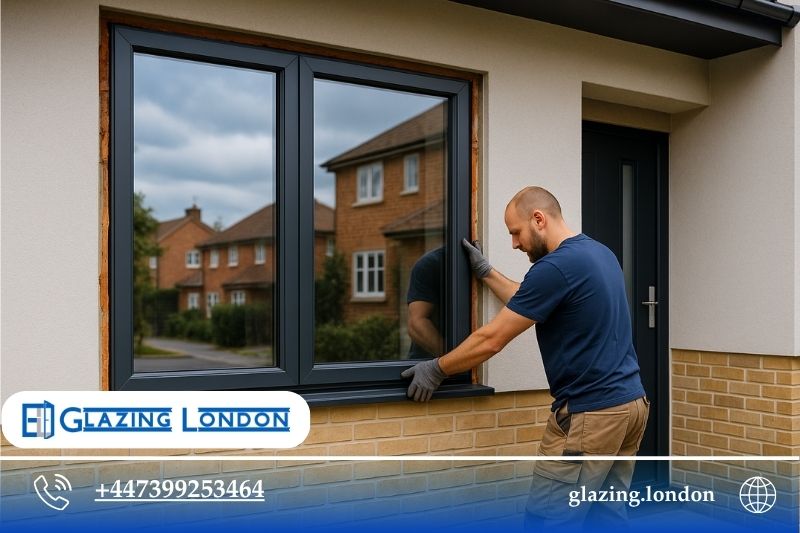Inside London’s busiest on-call glazing teams and the truth about what “fast response” really means .
INTRODUCTION: When a broken window becomes an emergency
Most people never think about glazing until the moment they desperately need it . One second you’re locking up your shop for the night , and the next you’re staring at shattered glass on the pavement . A storm blows through and the wind catches a weak frame . A football hits the front window of a café . A burglary attempt leaves a smashed door panel in the middle of your hallway . Whatever the situation , the feeling is the same – a jolt of panic , followed by the urgent question:
“How fast can someone get here?”
London doesn’t sleep . And because it doesn’t , windows don’t stop breaking at reasonable hours . They break at dawn . They break on Sundays . They break just after midnight when you are least ready to handle it . Emergency glazing exists for these moments , but the truth is that not all “emergency response times” are equal .
For some companies , “fast” means tomorrow morning .
For others , “fast” means within the hour .
And for the very few who specialise in genuine rapid response , “fast” means now .
This article explores what “fast enough” really means in London – a city where timing can be the difference between a minor inconvenience and a major safety risk . We will walk through real scenarios , on-the-ground realities , the psychology of emergency repair , and the hidden expectations behind the phrase “24/7 glazing” .
And along the way , we’ll find out what Londoners really need when they reach for emergency glazing services in the middle of chaos .
Double Glazing London
CHAPTER 1 — WHY SPEED MATTERS MORE THAN ANYTHING ELSE
When a window breaks , three things break with it: security , insulation and peace of mind . Most people don’t call an emergency glazier because of the glass alone . They call because the broken glass creates a vulnerable opening . That vulnerability sits in the mind like an alarm . It doesn’t matter if it’s your home , your shop , or your office – the reaction is instinctive .
A shop owner on Brixton Road told us that when her window shattered during a break-in , she didn’t look at the stock first . She looked at the gap in the glass and imagined how easily someone could climb through it . Her fear wasn’t the theft that had already happened , but the threat of a second intrusion before morning .
A homeowner in Streatham described a similar feeling when a stone cracked his sliding door at three in the morning . The noise woke him up . The cold entered the room almost instantly . The idea of sleeping – or even staying in the house – felt impossible until the opening was secured .
This is the fundamental reason why speed is the core promise of emergency glazing services . The quality of the repair is important , the materials matter , and the skill of the glazier determines the long-term result . But at the moment of crisis , none of that matters if they cannot get to you quickly . Emergency glazing is not just about expertise . It is about arrival time .
In London , where neighbourhoods can shift from quiet to chaotic within minutes , speed is not a luxury . It is the product .
Door Installation in London
CHAPTER 2 — HOW LONDON TRAFFIC SHAPES REAL RESPONSE TIMES
Anyone who has tried to move across London during rush hour knows that distance is a deceptive concept . A job in Lambeth may be physically close to one in Waterloo , but the journey can take twice as long as expected depending on the time of day , unexpected road closures , bus delays , or even football match traffic . Emergency glazing teams are shaped by this reality .
When a call comes in , the location isn’t just a pin on a map – it is a set of time variables . A glazier heading across Vauxhall Bridge at 4pm faces a completely different world compared to the same route at 2am . The challenge is that emergencies don’t schedule themselves during quiet traffic hours . They occur during storms , disruptions , riots , accidents and late-night events . They happen when London is busiest .
A genuine emergency glazing service must be structured in a way that neutralises London’s chaos . That means having glaziers stationed across different zones , vans stocked with the right materials , and routing tools that predict travel times with surprising accuracy . It also means having the discipline to dispatch instantly , not after finishing paperwork , admin calls or internal checks .
Many companies advertise 30-minute response times but work from a single depot . This is mathematically impossible during real London traffic . The companies that truly deliver rapid response operate more like emergency medical units than traditional trade services . They distribute themselves across the city , they anticipate peak hours and they train their teams to act the moment the phone rings .
In London , fast response isn’t an accident – it’s a system .

Window installation in London
CHAPTER 3 — THE MOMENT OF THE CALL: WHAT ACTUALLY HAPPENS
A surprising amount of psychology plays out when someone makes that first call for emergency glazing .
The caller is rarely calm . They speak quickly . They feel unsafe . Some apologise for sounding stressed . Others jump straight into describing the damage without even mentioning their name .
A trained glazing dispatcher listens differently . They’re not waiting for the full story . They’re extracting critical details immediately: address , access issue , type of property , size of the opening , any remaining hazards , and whether the situation involves a risk of injury or crime still in progress .
This is because the first five minutes determine the next two hours .
If the caller says a window was smashed during an attempted break-in and the street is still busy , the glazier needs additional protective equipment . If the opening is large enough for a person to fit through , boarding must be installed before glass fitting can even begin . If the glass is hanging dangerously , the team needs to stabilise the area before touching anything else .
A professional glazier team doesn’t just rush out the door . They prepare while they are on the phone . The van is loaded . The materials are selected . The tools are arranged for access . A good team knows what they are walking into before they arrive .
This is the difference between arriving fast and solving the problem fast .
uPVC Window Installation in London
CHAPTER 4 — WHAT “FAST ENOUGH” REALLY LOOKS LIKE
Let’s address the central question: How fast is fast enough?
The answer depends on the type of emergency .
When a shopfront window shatters at night , “fast enough” means arriving before the building becomes a target for opportunistic theft . A broken shopfront in London can attract unwanted attention within minutes , not hours .
When a homeowner calls after midnight , “fast enough” means reaching them before the fear of staying in the property becomes overwhelming .
When a childcare facility or school experiences a smashed panel , “fast enough” means getting there before students arrive or before the environment becomes unsafe for staff .
In reality , the most reliable emergency glaziers aim for an arrival time between 30 minutes and 90 minutes , depending on location and traffic . Anything beyond that creates risk . Anything shorter than that requires real logistical strength .
Why is this range acceptable?
Because “fast enough” is about preventing secondary damage:
Preventing burglary after the initial break
Preventing cold entering the property
Preventing water damage during storms
Preventing injury from falling shards
Preventing animals or intruders entering through the gap
The real mark of an expert glazier is not just how quickly they arrive , but how calmly the situation stabilises the moment they step through the door . Customers often describe the same feeling: relief . The presence of a professional is sometimes as valuable as the repair itself .
Aluminum Window Installation London
CHAPTER 5 — BOARDING UP: THE UNSUNG HERO OF EMERGENCY RESPONSE
Many Londoners imagine that emergency glazing means instant replacement with new glass . But in most cases , the first and most important step is boarding up the opening . This temporary solution is often misunderstood . Boarding isn’t a low-quality patch . It is a highly strategic safety measure .
Boarding protects the property from trespassers , protects the people inside from weather conditions and stabilises the area while the replacement glass is being measured , cut and delivered . Some types of glass require specialised cutting that cannot happen on the spot . It’s safer to secure the opening with durable boards than to rush an improper installation .
The speed of boarding reflects the quality of the emergency glazing team . A well-trained professional can board a shopfront or door panel with precision , ensuring no gaps , no weak corners , and no access points . When done correctly , boarding can turn a broken window into a secure barrier within minutes of arrival .
This is why “fast enough” is not just about replacing the glass .
It is about securing the property immediately while arranging the permanent fix .

Double Glazing Window Installation in London
CHAPTER 6 — THE HIDDEN FACTORS THAT SLOW COMPANIES DOWN
Customers often wonder why some companies take hours to respond . The reasons are rarely visible from the outside , but they make a massive difference in performance .
Some companies operate from a single location and don’t have distributed glaziers . Others rely on subcontractors who may be busy or too far from the site . Some don’t keep emergency materials stocked in their vans , forcing them to stop at suppliers before attending . Others delay dispatching until full details are collected .
The biggest difference , however , lies in the mindset .
A company built for emergency response behaves like a fire service .
A company built for convenience behaves like a calendar scheduler .
One of our senior glaziers once said:
“We don’t wait for a full story . We move first and ask later .”
This is the mentality of real emergency service providers .
CHAPTER 7 — REAL SCENARIOS FROM LONDON
A restaurant in Clapham had its front window smashed by a delivery scooter accident during dinner service . Customers were still inside . The team arrived within 40 minutes , boarded the window safely and the restaurant stayed open for the rest of the evening .
A pharmacy in Oval faced a break-in attempt at 4am . Glass was shattered , but the property was still at risk . The glazier arrived in under an hour , secured the opening and prevented further damage .
A family home in Kennington had a cracked patio door during a storm . The team arrived shortly after midnight . The family said the moment the glazier arrived , the house “felt safe again” .
These stories highlight something essential:
A fast response is not just operational efficiency . It is emotional care .
emergency glazing
CHAPTER 8 — THE COST OF BEING TOO SLOW
Delayed response times create more damage than people realise .
A shop left exposed overnight may face a second break-in .
An office left unsecure may invalidate insurance conditions .
A home left open may suffer weather damage that costs thousands to repair .
A broken door panel may allow intruders easy access .
Slow response times cost far more than the emergency service itself .
This is why the phrase “fast enough” must be taken seriously .
Fast enough is the arrival time that prevents secondary damage .
Fast enough is the arrival time that restores safety .
Fast enough is the arrival time that lets the customer breathe again .
CHAPTER 9 — WHY TRUE 24/7 SERVICE IS HARDER THAN IT SOUNDS
Many companies claim to operate 24/7 . But real 24/7 service requires rotating schedules , night-shift glaziers , fully stocked vans at all hours , and dispatch coordination that never sleeps . It requires stamina , dedication and a deep sense of responsibility .
A real emergency glazing team doesn’t “wake up” to your call .
They are already awake , alert and ready .
CHAPTER 10 — WHAT CUSTOMERS SHOULD EXPECT
While customers can’t control traffic , weather or city events , they deserve clear expectations .
A professional emergency glazier should:
Answer the phone on the first or second ring .
Give a realistic time of arrival , not an optimistic one .
Dispatch immediately .
Arrive prepared , not empty-handed .
Stabilise the scene fast .
Communicate clearly and calmly .
Provide boarding if glass replacement cannot be done instantly .
Offer a timeline for full replacement .
When these expectations are met , “fast enough” becomes a promise , not a hope .

CONCLUSION: SO WHAT IS FAST ENOUGH?
Fast enough is the moment you feel safe again . Fast enough is the response time that stops the damage from spreading . Fast enough is the arrival window that turns panic into calm .
In London , with its unpredictable streets and fast-moving environment , “fast enough” is typically within 30 to 90 minutes , depending on the distance . Anything longer risks property , comfort and peace of mind .
Emergency glazing isn’t about glass . It’s about security . It’s about reassurance . It’s about restoring order in the middle of disorder .
When your window breaks , the clock starts ticking .
A real emergency glazing service knows that every minute has a consequence .
That’s why the best teams in London don’t just aim to be fast .
They aim to be fast enough to matter .





